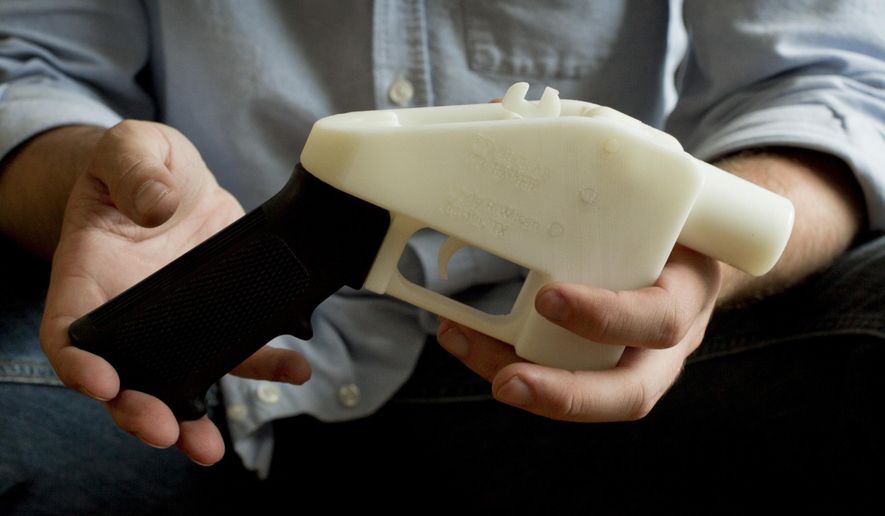A federal judge issued a temporary restraining order Tuesday blocking a Texas organization from posting new online blueprints for 3D-printed guns, delivering a last-minute win to gun control backers who were worried about the implications of untraceable firearms being manufactured at home.
Defense Distributed had planned to make 3D blueprints widely available over the internet on Wednesday, but U.S. District Judge Robert S. Lasnik ordered a halt and reimposed Obama-era restrictions that blocked the plans’ distribution. The Trump administration reversed the rules this year.
“There is a possibility of irreparable harm because of the way these guns can be made,” said Judge Lasnik, setting a broader hearing for Aug. 10.
Cody Wilson, founder of Defense Distributed, said he was disabling downloads until he had a chance to study the judge’s ruling, according to CNN.
Democratic state attorneys general who led the lawsuit called Judge Lasnik’s decision and a similar but more limited ruling by a judge in New Jersey major wins for their side and a rejection for the Trump administration.
“Once again, my office had to hold this administration accountable to the rule of law,” said Washington state Attorney General Bob Ferguson, who led the states in suing.
Plans for printing 3D guns would let people with access to the right machinery and materials make a working, untraceable firearm in secret. The concept has managed to plow new ground in the decades-old debate over gun rights and government regulations.
Some security specialists worry that the guns could circumvent metal detectors and become tools for terrorists. Gun control activists say people banned from buying guns, such as felons and domestic abusers, also would be able to cheat the law by printing weapons at home.
Defense Distributed counters that what it’s doing is releasing information protected by free speech, not engaging in firearms transactions.
“We are disappointed in this ruling, which will result in a global injunction on the freedom of speech,” said Josh Blackman, a professor at South Texas College of Law who is part of Mr. Wilson’s legal team.
Mr. Wilson first posted firearms blueprints online several years ago. In 2013, the Obama administration’s State Department said the blueprints could be violating export rules. The organization said it wouldn’t post any more plans but sued to try to overturn the policy.
The Trump administration concluded that it would lose the case after years of legal wrangling and reached a settlement with Defense Distributed. It withdrew the objection and allowed publication.
President Trump suggested Tuesday that he wasn’t on board with that decision.
“I am looking into 3-D Plastic Guns being sold to the public. Already spoke to NRA, doesn’t seem to make much sense!” the president tweeted.
He didn’t elaborate, but the White House and the National Rifle Association followed up by saying undetectable plastic guns are already illegal under federal law.
“The administration supports this nearly 2-decade-old law,” said White House spokesman Hogan Gidley. “We will continue to look at all options available to us to do what is necessary to protect Americans while also supporting the First and Second amendments.”
Democrats, meanwhile, said Mr. Trump’s late alarm seemed disingenuous.
Sen. Richard Blumenthal of Connecticut said the president would have blood on his hands the first time someone is killed with one of the weapons. Other Democrats warned of a rash of 3D rifles.
“The ball’s in his court — he has a chance to prevent this from happening,” said Sen. Edward J. Markey, Massachusetts Democrat. “Donald Trump will be totally responsible for every downloadable, plastic AR-15 that will be roaming the streets of our country if he does not act today.”
Mr. Markey and fellow Democrats announced legislation Tuesday to outlaw publication of 3D firearms blueprints.
Judge Lasnik’s move takes some of the urgency out of that effort.
The judge acknowledged that First Amendment issues were at stake but said the prevalence of 3D printers on college campuses and other public spaces made the risks too high to allow plans to be posted without a more thorough review.
The coalition of liberal states that sued argued that the Trump administration cut corners when it reversed the Obama administration’s objections, which were, formally speaking, a claim that publishing plans on the internet constitutes an export of weapons, which is illegal without State Department approval.
The states also said that allowing 3D-printed guns would circumvent states’ rights to enforce gun control laws.
But the State and Justice departments, in contrast with Mr. Trump’s objections, defended the government’s reversal.
Officials said some blueprint files are already posted online and suggested that this week’s fight is misplaced.
“They have been available not just from this one website, but many websites,” said Heather Nauert, a State Department spokeswoman. “I’m not defending that at all, but I want folks to know this is not something that has only recently become available, and it is, in fact, whether people like it or not, it is legal for American citizens to download this information.”
Although plastic can avoid metal detectors at airports and elsewhere, the vast majority of existing 3D-gun plans use at least some metal parts, and bullets still are made of metal.
⦁ This article is based in part on wire service reports.
• David Sherfinski can be reached at dsherfinski@washingtontimes.com.




Please read our comment policy before commenting.